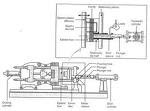Associations between physically demanding manual handling of materials and work-related musculoskeletal injury have been well documented by ergonomists and epidemiologists.
Mechanized assistive devices are widely used to control such problems. Material-handling systems can be generally categorized as positioners (e.g., lift tables, conveyors), used to place or orient objects, and manipulators (articulated arms, hoists), used to move and/or support objects. The latter were the focus of a detailed ergonomic/biomechanical analysis,
with a goal of understanding the impact of using manipulators on task performance and the
user’s physical demands.
Only minimal investigation has been conducted on manipulators, mainly focusing on biomechanical modeling of the static gravitational component. While use of manipulators reduces the static component (i.e., object weight), substantial kinetic loads may result from body segment dynamics and the inertial dynamics of the manipulator and object handled. In addition, use of a manipulator frequently requires complex body postures and motions.
In the first study,two mechanical manipulators (an articulated arm and an overhead hoist; Fig. 2) were used to move objects with moderate masses (10–40 kg) for several shortdistance transfers. Differences between the two devices and manual (unassisted) movements were obtained for motion times, applied hand forces, and torso kinematics. Use of either manipulator increased motions times by 36–63% for symmetric motions (in the y–z plane) and by 62–115% for asymmetric motions (in the x–z plane). Hand forces were substantially lower when using either manipulator (by 40–50%), while torso motions were generally similar regardless of how the transfers were conducted. For self-paced job tasks (see below for effects of pacing), it was concluded that moderate-mass objects require significant increases in motion times, but with substantially reduced levels of upper extremity exertion.
A second study examined physical loads in more detail using the same manipulators and motions. A 3D inverse dynamics biomechanical model was developed to allow for estimation of the strength demands (required moments versus joint strength) at the shoulders and low back as well as compressive and shear forces in the lower spine (the latter as estimates of the relative risk of low-back injury). Strength demands decreased substantially when using either manipulator in comparison to transfers done manually. Strength demands were also much less affected by increases in object mass. Spine compression and shear were
reduced by roughly 40% when using either manipulator, primarily because of the decreased hand forces noted above and the resulting spinal moments. Estimates of trunk muscle activity (using EMG) suggested that the use of a hoist imposes higher demands on coordination and stability, particularly at extreme heights or with asymmetric motions. In contrast, the articulated arm imposed higher demands on strength and resulted in increased spinal compression, likely because of the higher system inertia. From both studies, it was concluded that use of either type of manipulator can reduce physical demands compared with manual methods, though performance (motion times) will be compromised. In addition, either a hoist or articulated arm may be preferable depending on the task requirements (e.g., height and asymmetry).
Two companion studies were conducted to address additional aspects of manipulators as used in practice. Effects of short-term practice (40 repetitions) were addressed in the first study,13 using the two manipulators to lift and lower a 40-kg object. Nonlinear decreases in several measures were found (e.g., low-back moments and spine compression). These decreases, however, were fairly slow and comparable to rates of learning for manual lifting. Familiarization with material-handling manipulators is thus recommended, and the learning process may be somewhat lengthy. Effects of pacing (speed of object transfer) were determined
in the second experiment14 by having participants perform transfers 20% more rapidly than those presented above. This requirement led to roughly 10% higher hand forces, 5– 10% higher torso moments, similar torso postures and motions, and 10% higher spine loads (compression and shear). When manipulators are used in paced operations (e.g., assembly lines) and the noted increases in required motion times are not accounted for, these results suggest that the risk of musculoskeletal injury may be increased.
Maury A. Nussbaum
Industrial and Systems Engineering
Virginia Polytechnic Institute and State University
Blacksburg, Virginia
Jaap H. van Diee¨n
Faculty of Human Movement Sciences
Vrije Universiteit
Amsterdam, The Netherlands
Mechanical Engineers’ Handbook: Materials and Mechanical Design, Volume 1, Third Edition.
Edited by Myer Kutz
Copyright 2006 by John Wiley & Sons, Inc.

















